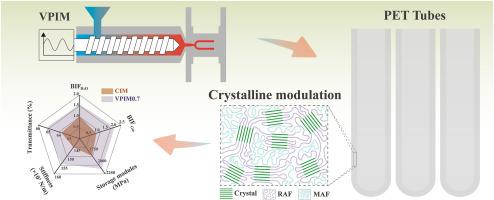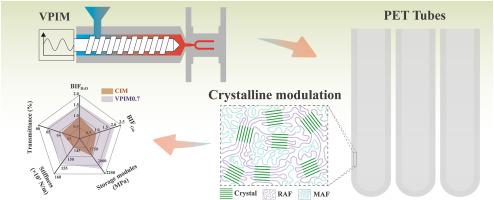In-situ enhancement of barrier properties in PET blood collection tubes via volume-pulsation injection molding
IF 4.5
2区 化学
Q2 POLYMER SCIENCE
引用次数: 0
Abstract
The barrier properties of polyethylene terephthalate (PET) blood collection tubes are crucially determinant for maintaining blood specimen integrity. However, conventional modification strategies, such as incorporation of nanofillers and surface functionalization, may introduce potential biocompatibility risks and increase costs. Herein, an innovative volume-pulsation injection molding (VPIM) is employed to achieve in-situ enhancement of barrier properties in PET blood collection tubes. VPIM technology can promote a conformational transition from gauche to trans conformers, which induces condensed crystalline domains and reduces volume fraction of rigid amorphous fraction (RAF), thereby optimizing permeation pathways and forming a percolation-resistant barrier architecture. When the pressure-holding frequency reaches 0.7 Hz, the water vapor transmission rate (WVTR) and the gas transmission rate (GTR) are reduced to 0.73 g/(m2·24 h) and 2.95 cm3/(m2·24 h·0.1 MPa), respectively, resulting in the improvements by 35.4 % and 50 % compared with conventional injection molding (CIM), respectively. This work establishes a new processing method for microstructure engineering via dynamic force field modulation, offering an eco-friendly manufacturing strategy for self-enhancement of medical polymer products.


容积脉动注射成型原位增强PET采血管屏障性能
聚对苯二甲酸乙二醇酯(PET)采血管的屏障特性是维持血液标本完整性的关键决定因素。然而,传统的改性策略,如纳米填料的掺入和表面功能化,可能会带来潜在的生物相容性风险并增加成本。本文采用一种创新的容积脉动注射成型技术(VPIM)来实现PET采血管屏障性能的原位增强。VPIM技术可以促进从间式构象到反式构象的转变,从而诱导凝聚态晶域,减少刚性非晶态分数(RAF)的体积分数,从而优化渗透途径,形成抗渗透屏障结构。当保压频率达到0.7 Hz时,水蒸气透过率(WVTR)和气体透过率(GTR)分别降至0.73 g/(m2·24h·0.1MPa)和2.95 cm3/(m2·24h·0.1MPa),分别比常规注射成型(CIM)提高35.4%和50%。本文建立了一种基于动态力场调制的微结构工程加工新方法,为医用高分子材料的自增强制造提供了一种生态友好型制造策略。
本文章由计算机程序翻译,如有差异,请以英文原文为准。
求助全文
约1分钟内获得全文
求助全文
来源期刊

Polymer
化学-高分子科学
CiteScore
7.90
自引率
8.70%
发文量
959
审稿时长
32 days
期刊介绍:
Polymer is an interdisciplinary journal dedicated to publishing innovative and significant advances in Polymer Physics, Chemistry and Technology. We welcome submissions on polymer hybrids, nanocomposites, characterisation and self-assembly. Polymer also publishes work on the technological application of polymers in energy and optoelectronics.
The main scope is covered but not limited to the following core areas:
Polymer Materials
Nanocomposites and hybrid nanomaterials
Polymer blends, films, fibres, networks and porous materials
Physical Characterization
Characterisation, modelling and simulation* of molecular and materials properties in bulk, solution, and thin films
Polymer Engineering
Advanced multiscale processing methods
Polymer Synthesis, Modification and Self-assembly
Including designer polymer architectures, mechanisms and kinetics, and supramolecular polymerization
Technological Applications
Polymers for energy generation and storage
Polymer membranes for separation technology
Polymers for opto- and microelectronics.
 求助内容:
求助内容: 应助结果提醒方式:
应助结果提醒方式:


